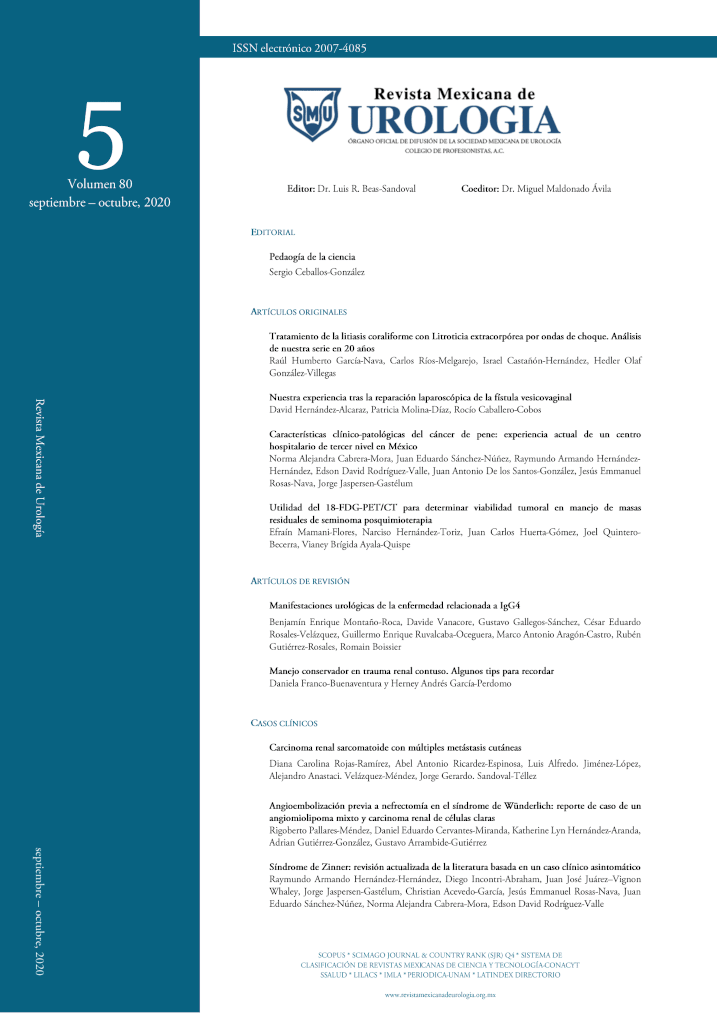Zinner syndrome: an up-to-date literature review based on an asymptomatic clinical case
DOI:
https://doi.org/10.48193/revistamexicanadeurologa.v80i5.620Keywords:
Zinner syndrome, monoreneum, seminal vesicle cyst, mesonephric ductsAbstract
Clinical case description: A 38-year-old man initially presented with anuria secondary to a right solitary kidney and a stone in the lower third of the ureter that was resolved through laser ureterolithotripsy. As part of his evaluation, extension studies were performed that identified a cyst in the left seminal vesicle.
Relevance: Due to the mutual embryologic origins of the seminal vesicle, vas deferens, and ureteric bud, developmental alterations of the mesonephric duct (Wolffian duct) and the absence of the ureteric bud during the first trimester of gestation are associated with ipsilateral renal agenesis and ejaculatory duct atresia that will later progress to cystic dilation of the seminal vesicle.
Conclusions: Zinner syndrome was first described in 1914 and it continues to be a rare condition worldwide. In fact, only approximately 200 cases have been reported in the literature.
References
Florim S, Oliveira V, Rocha D. Zinner syndrome presenting with intermittent scrotal pain in a young man. Radiology Case Reports. 2018 Dec;13(6):1224–7. doi: https://doi.org/10.1016/j.radcr.2018.08.012
García Asensio D, Fernández Martín M. Síndrome de Zinner diagnosticado en edad pediátrica. Radiología. 2016 Jan;58(1):73–4. doi: https://doi.org/10.1016/j.rx.2015.08.004
Symeonidis EN, Gkekas C, Tsifountoudis I, Symeonidis A, Georgiadis C, Kalyvas V, et al. Incidental finding of Zinner syndrome in a Greek military recruit: a case report of a rare clinical entity. Mil Med Res. 2019 Feb 14;6. doi: https://dx.doi.org/10.1186%2Fs40779-019-0194-9
Pereira BJ, Sousa L, Azinhais P, Conceição P, Borges R, Leão R, et al. Zinner’s syndrome: an up-to-date review of the literature based on a clinical case. Andrologia. 2009 Oct;41(5):322–30. doi: https://doi.org/10.1111/j.1439-0272.2009.00939.x
King BF, Hattery RR, Lieber MM, Berquist TH, Williamson B, Hartman GW. Congenital cystic disease of the seminal vesicle. Radiology. 1991 Jan;178(1):207–11. doi: https://doi.org/10.1148/radiology.178.1.1984306
Tan Z, Li B, Zhang L, Han P, Huang H, Taylor A, et al. Classifying seminal vesicle cysts in the diagnosis and treatment of Zinner syndrome: A report of six cases and review of available literature. Andrologia. 2020 Feb;52(1):e13397. doi: https://doi.org/10.1111/and.13397
Kanavaki A, Vidal I, Merlini L, Hanquinet S. Congenital Seminal Vesicle Cyst and Ipsilateral Renal Agenesis (Zinner Syndrome): A Rare Association and Its Evolution from Early Childhood to Adolescence. European J Pediatr Surg Rep. 2015 Dec;3(2):98–102. doi: https://doi.org/10.1055/s-0035-1555605
Beeby DI. Seminal Vesicle Cyst Associated with Ipsilateral Renal Agenesis: Case Report and Review of Literature. Journal of Urology. 1974 Jul;112(1):120–2. doi: https://doi.org/10.1016/s0022-5347(17)59657-3
Williams RD. Surgery of the seminal vesicles. Campbell’s urology. 1998;3:3299–315.
Altobelli E, Bove AM, Falavolti C, Sergi F, Nguyen HT, Buscarini M. Robotic-assisted laparoscopic approach in the treatment for Zinner’s Syndrome associated with ipsilateral megaureter and incomplete double-crossed ectopic ureter. Int Urol Nephrol. 2013 Jun;45(3):635–8. doi: https://doi.org/10.1007/s11255-013-0412-4
Seo IY, Kim HS, Rim JS. Congenital seminal vesicle cyst associated with ipsilateral renal agenesis. Yonsei Med J. 2009 Aug 31;50(4):560–3. doi: https://doi.org/10.3349/ymj.2009.50.4.560






